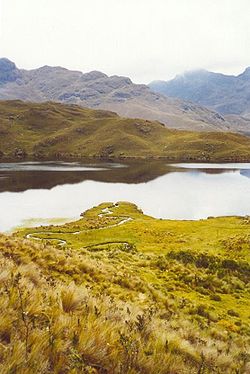El Cajas National Park
| El Cajas National Park | |
|---|---|
Azuay Province | |
| Nearest city | Cuenca |
| Coordinates | 02°50′46″S 79°13′13″W / 2.84611°S 79.22028°W |
| Area | 285.4 km2 (110.2 sq mi) |
| Established | November 5, 1996 (Resolution N° 057) |
| Official name | Parque Nacional Cajas |
| Designated | 14 August 2002 |
| Reference no. | 1203[1] |





El Cajas National Park or Cajas National Park (
Name
The name "Cajas" is derived from the
Geography and climate
The highest point is the 4,450 m high Cerro Arquitectos (Architects Hill), and the elevation of roads reaches higher than 4,310 meters (13,550 feet). About 270
The climate shows an average temperature of 13.2 °C and an average annual precipitation of 1,072 mm. Clouds typically drift up from the Pacific coast and from the Paute river basin (near Cuenca) and bring humidity.
Ecology
Flora
Humidity and high altitude with low atmospheric pressure create an ecosystem that accumulates organic material in the soil that is able to retain water. The high grassland ecosystem (páramo) contains plants suitably adapted to it, 19 of them endemic to Cajas. The dominant plant is straw grass (Calamagrostis intermedia).
Above 3,300 meters the "queñua" or "paper tree" (Polylepis) forest is found. It is in forests such as these that a second protected population of the rare Fuchsia campii, in the family Onagraceae, is predicted to live, as it has also been found in another nearby national park of similar ecological characteristics.[4]
In the lower parts of the park, the cloud forest and perennial high mountain forest are present, primarily in the ravines near the brooks and rivers.
Fauna
The Cajas National Park is home to a large variety of animals, some of which are
Overall, forty-four mammalian species have been identified in the park. Species include types of
At least seventeen species of amphibians live around the lagoons of Cajas. This includes those of the genera Atelopus, Telmatobius, Gastrotheca, Eleutherodactylus, and Colostethus. The high variety of amphibians suggests the presence of a diversity of insects, as they are a chief amphibian food source.
Archeology
The area shows evidence of human activities already from the
International listings
Cajas is listed as a
See also
References
- ^ "Parque Nacional Cajas". Ramsar Sites Information Service. Retrieved 25 April 2018.
- ^ a b c d e "Parque National Cajas", map and brochure from Etapa, Cuenca, 2009
- ^ a b Cajas Park information
- )
- ^ Boris A. Tinoco; Pedro X. Astudillo; Steven C. Latta; Catherine H. Graham (2008). "Distribution, ecology and conservation of an endangered Andean hummingbird: the Violet-throated Metaltail" (PDF). Archived from the original (PDF) on 2011-09-28.
{{cite journal}}: Cite journal requires|journal=(help)
